HOUSING, DINING & AUXILIARY ENTERPRISES IS PROUD to display a modest and eclectic art collection on view in various locations throughout its residences, dining facilities and grounds. Comprised of various mediums—sculpture, painting, photography, fluorescent light—spanning both history and geography, each piece offers an artistic element unique to the individual space where it is exhibited. HDAE has joined the larger UCSB art policy group in an ongoing collaboration to inventory and catalogue artwork across campus. With an intent to track, preserve, protect and display art objects, the group aims to foster interactive engagement, education and enjoyment for the wide audience that makes up the UCSB campus community.
| Image | Artwork | Description |
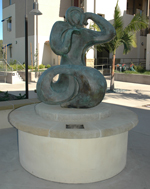 |
Title: Optimism Eternal Artist: Luciano Tempo Media: Bronze Location: San Clemente Encino Quad |
The top section of the sculpture, a female shape with her hands toward the sky expresses hope and gratitude, while the lower section is reminiscent of the Eastern serpent biting its tail as a symbol of eternity, a beautiful marriage of concepts. This sculpture stood as an anchoring piece in the artist’s personal garden in Carmel California, where his main gallery was situated. |
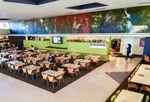 |
Title: The Odyssey Artist: Howard Warshaw Media: fresco Location: Ortega Commons |
The mural was painted in the late 1950's by Howard Warshaw, a professor in the College of Creative Studies. It was his visual interpretation of the epic poem by the Greek philosopher, Homer. The story (and painting) chronicles the journey and adventures of Odysseus as he returns home to Ithaca after the Trojan War. Warshaw felt this would be an appropriate theme for students venturing on their own journeys from home, through college, and beyond. The 76 foot wall above Ortega's dining room offered an incredible 'canvas.’ Warshaw volunteered to paint the mural free of charge with the agreement that it be displayed as long as the building remained standing. The University agreed and a contract was signed and dated. He began with a series of design sketches and color studies (see WARSHAW: a Decade of Murals in the UCSB Arts Library). Painting began in 1958 and continued into the early 1960’s. In all, he spent almost four years on the catwalk above the dining room, painting at all hours of the day and night. Upon completion, an ecstatic Warshaw penned an enormous signature on the final section. He would later return to pen a smaller version which remains today on the far right of the painting. |
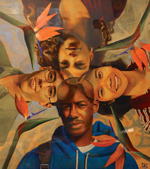 |
Title: Everyday People Artist: John Trevino, UCSB Student Class of 1995 Media: painting Location: Main HDAE Office |
|
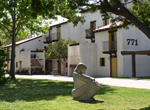 |
Title: The Women Artist: Linda Murray, UCSB Student Media: metal/wood sculpture Location: Storke I Family Housing |
In the late 1980s Janet Vandevender, the then Director of the Women’s Center, offered this statue to Richard Frost for Family Student Housing. The statue, featuring a single seated figure, was created by UCSB student artist Linda Murray and is titled “The Women." |
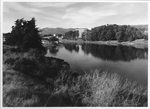 |
Title: San Nicolas Hall Artist: Ansel Adams Media: b&w photo Location: To the right of the San Nicolas Front Desk |
|
 |
Title: Trip to Topawa, 2022 Artist: Ishi Glinsky (b. Arizona, 1982) Media: Acrylic ink, oil stick and matte medium on canvas Location: The Club at UCSB |
Working in a variety of media, which includes painting, drawing and sculpture, artist Ishi Glinsky investigates the traditional practices of his tribe, the Tohono O’odham Nation, as well as other North American First Nations to create contemporary homages to sacred events and customs. These investigations often consist of a close study of the history and significance of a craft tradition, the committed apprenticeship of its technique, and its assimilation or transformation within Glinsky’s artistic practice. In Trip to Topawa, Glinsky both studies and celebrates Tohono O’odham basketry by coiling and spiraling together indigenous knowledge to consider the collision of different worlds. The work begins with two portraits of Tohono O'odham basket weavings sitting next to one another. In the words of the artist: “I am considering how each of these baskets are made and the indigenous knowledge and understanding of what is happening all around us, that allows for these creations to come into existence. From my perspective I see an action of spiraling outward, formed at the core of these two original baskets. One basket executed using rebar wire contrasted with the other work rendered from bear grass, devils claw, and yucca. These designs have momentum, seemingly reflecting what is happening in the cosmos above. When uniting each of these works on one canvas I envision a clashing of galaxies, acted out in weavings of wire and desert harvested materials, then, skewed, and explored on this canvas.” -Ishi Glinsky, 2023 |
 |
Title: Neon Banners Artist: Unknown Reproduction Media: neon sculptures Location: The Club at UCSB |
Per Dennis Whelan, in an email dated 9/30/2015: “The Neon banners are a spoof of the old-time club, skewering the pretentious illusions of the Academic Men’s club of a 19th century baronial hall, or of Hearst Castle’s dining hall lined with medieval flags, here reinterpreted into the pop-art of the 1960s. The banners were designed by respected lighting professional Richard Peters and William Grover a Yale professor with whom Moore had been a frequent collaborator. The collection of colorful neon banners were made in New Haven and driven here in a station wagon. They were mounted on metal stemmed globe light fixtures protruding from walls, which sort of resembled the kind of trumpets that velvet-shoed heralds once played in medieval castles. Other pieces incorporated into the building were fifteenth-century mudéjar Ceiling panels from Toledo, Spain, carved wood that were painted and gilded, and acquired from the Hearst estate along with baronial–style furniture, animal heads and a silk tapestry. As an assembly of parts, above all, the Faculty Club was a place meant to have fun. These types of gestures were not universally popular, and perhaps even meant to irritate, which they did to an unfortunate success. The interior offended those whose artistic taste was more traditional. Ten years after its completion, in 1978 a club rehabilitation by Chancellor Robert Huttenback and his wife Frieda by Montecito decorator Richard Byers, removed or changed several original elements: the banners, the tapestries and stuffed heads. The banners were never found. As a student of Charles Moore during my Graduate years at UCLA, and later as a campus planner at UCSB, I [Dennis Whelan] took the initiative to have the banners restored. They were recreated from original photographs and drawings (from William Grover) by a fabricator in Oxnard. I raised $5,000 in donations from friends and club members to have them reinstalled in 2001. There still remains one missing banner, made of silver Mylar.” |